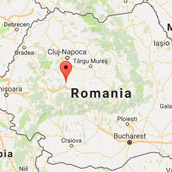Historical Background
 Town in the central western area of Romania, on the Mureş River. Alba Iulia (known in German as Karlsburg; Ladino as Carlisburg; Latin as Alba Carolina [or Apulum in ancient Roman times]; and Hungarian as Gyulafehérvár) served from 1542 to 1690 as the capital of the autonomous principality of Transylvania under Turkish suzerainty. It was then part of Hungary until it was annexed to Romania after World War I.
Town in the central western area of Romania, on the Mureş River. Alba Iulia (known in German as Karlsburg; Ladino as Carlisburg; Latin as Alba Carolina [or Apulum in ancient Roman times]; and Hungarian as Gyulafehérvár) served from 1542 to 1690 as the capital of the autonomous principality of Transylvania under Turkish suzerainty. It was then part of Hungary until it was annexed to Romania after World War I.
Jews had a documented presence in Alba Iulia by the end of the sixteenth century. In 1653, the region’s code of laws (the Approbatae Constitutiones) required all Jews in Transylvania to live exclusively in this town. According to the testimony of the Swedish traveler Conrad Iacob Hiltenbrandt (1656), Jews had already established a synagogue there by the middle of the seventeenth century. In the first half of the eighteenth century, Habsburg rule extended earlier privileges, which had been granted by the princes of Transylvania, to allow Jews free trade and a distinct community life.
Until 1879, the rabbis of Alba Iulia were considered to be the chief rabbis of all Jews in Transylvania. Among those who held this position were Avraham Yitsḥak Russo (1736–1738), Yosef Auerbach (1742–1750), Yonatan Trebitsch (1752), Binyamin Ze’ev Wolf (1764–1777), Mosheh ben Shemu’el Levi Margolioth (1778–1817), Menaḥem Mendel (1818–1823), Yeḥezkel Paneth (1823–1845), and Avraham Friedman (1845–1879). According to minute books, kept in Hebrew, Yiddish, Ladino, Spanish, Hungarian, and Romanian between 1736 and 1835, the Jewish community of Alba Iulia was administered by a president, a committee of five to seven members, and a bet din(rabbinical court) composed of three to five members.
By the late eighteenth century, Jews had settled in other parts of Transylvania despite the existing legal restrictions. In 1779, Empress Maria Theresa once again ordered all Jews living in Transylvania to be concentrated in Alba Iulia; this plan, however, was put on hold by her son, Emperor Joseph II, who also allowed for the building of a Sephardic synagogue, a project that had been proposed as early as 1774. Construction took more than a century to complete, as the synagogue was not opened until 1886. It functioned until about 1980, when the Communist government demolished it.
The numbers of Jewish families in Alba Iulia increased from 12 in 1689 to 54 in 1754. The numbers of individuals rose from 150 people in 1785–1786 to 220 in 1813, followed by steady increases totaling 264 in 1838; 735 in 1850–1851; 1,221 in 1869; 1,357 in 1891; 1,586 in 1910 (13.6% of the total population); and 1,558 in 1930 (12.7%). After the civil emancipation (1867) and the Congress of Jews from Hungary and Transylvania (1868–1869), the community of Alba Iulia adopted the Status Quo orientation (neither Orthodox nor Neolog). Rabbis who served the community included Kálmán Weisz (1880–1891), Sándor Fischer (1892–1928), and Mór Krausz (1928–1948). Between 1928 and 1932, a distinct Orthodox community also existed. In 1932, the community became unified and fully adopted Orthodoxy, including a Sephardic section.
The Siebenbuerger Israelit newspaper was published in Alba Iulia in 1883. The artist and sculptor László Keleti worked there after World War I. The surge of antisemitism between the two wars culminated in Alba Iulia with the destruction of the Ashkenazic synagogue in 1938 by members of the Iron Guard. Between 1940 and 1944, the community suffered the severe consequences of anti-Jewish legislation and policies adopted by the Antonescu regime. Some rebuilding of community life after the Holocaust led to an increase in the number of Jews in 1947 to 2,070 persons, but emigration over the following decades brought the Jewish presence in Alba Iulia to symbolic dimensions; in 2003, just 45 Jews remained.
Suggested Reading
Moshe Carmilly-Weinberger, A zsidóság története Erdélyben (1623–1944) (Budapest, 1995), pp. 164–167; Ladislau Gyémánt, The Jews of Transylvania in the Age of Emancipation (1790–1867)(Bucharest, 2000), pp. 236, 335–339; Pinkas ha-kehilot. Romanyah: Entsiklopedyah shel ha-yishuvim ha-Yehudiyim le-min hivasdam ve-‘ad le-aḥar Sho’at milḥemet ha-‘olam ha-sheniyah(Jerusalem, 1970), vol. 1, pp. 277–279.
Author
Translation
Translated from Romanian by Anca Mircea
From
Ladislau Gyémánt, "Alba Iulia." In: YIVO Encyclopedia of Jews in Eastern Europe.
New Haven: Yale University Press, 2008. Accessed December 5, 2016.
Reproduced by permission of Yale University Press.
 The YIVO Encyclopedia of
The YIVO Encyclopedia of